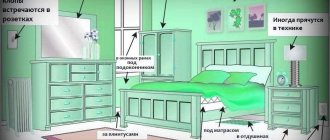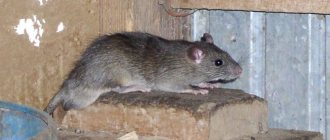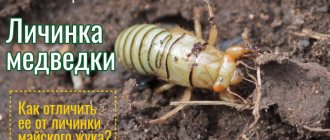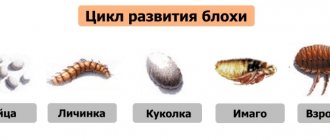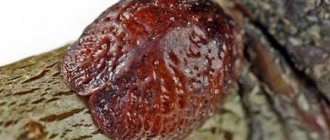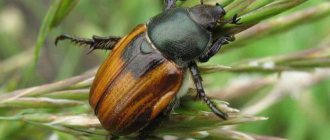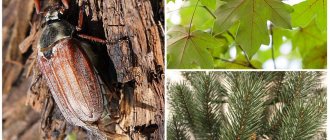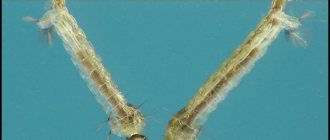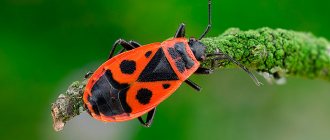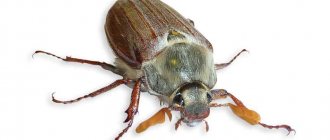Blood-sucking insects, which live mainly on the skin and fur of domestic animals, bring a lot of trouble to humans. Flea bites can lead to allergies, and especially impressionable people simply find it unpleasant to be in an apartment infested with parasites, which is understandable. In addition, in theory, parasites can be carriers of many dangerous infectious diseases, although in practice cases of infection from pests are extremely rare.
Before starting an active fight against fleas, you should determine whether these particular parasites are actually infested in your home, and not, for example, bedbugs or linen lice. That is why you should know how to identify adults (as well as larvae, pupae, eggs) and distinguish them from other common pests.
Adults
The parasites that most insecticides target are adult fleas. An adult insect can reach up to 5 millimeters in size, has a black (these are young fleas) or brown color, and is covered with scales. In the animal's fur, the pest is somewhat reminiscent of a small grain of a plant.
The main difference between fleas and other insects: pests can jump up to thirty centimeters in length, escaping from danger or moving from victim to victim. Sometimes these jumps can be seen with the naked eye. Fleas differ from bed lice in their large size, and from bedbugs in their ability to jump.
Structural features
The body of fleas is laterally compressed, narrow, smooth, equipped with bristles and spines that help them move and stay in the thick fur and between the feathers of their hosts, in the folds of clothing, as well as in the substrate of their nests and burrows. The head and chest often have serrated ridges (ctenidia).
The size of fleas of different species varies from 1 to 5 mm, but in females of some species it can reach 10 mm due to the hypertrophic growth of the abdomen after the start of feeding.
The antennae are always located behind the simple eyes and, at rest, are placed in special recesses - antennal fossae.
The antennae may be used by males to hold the female during copulation. The oral apparatus of fleas is of the piercing-sucking type.
It is characterized by the transformation of epipharynges (unpaired stylet) and lacinia (paired stylets) into stylets, articulated with the maxillary lobes.
The lower lip with a pair of labial palps is transformed into case flaps for the components of the proboscis. The mandibles in adult fleas are completely lost. The chest is equipped with strong limbs, providing the insect with rapid movement in the host's integument and the ability to stay on rough surfaces at any angle.
They often move by jumping, using the second and especially the third pair of legs to push. In the posterior part of the abdomen, behind tergite VIII, there is a unique sensory organ found only in fleas - the abdominal sensillium, or pygidium, equipped with trichobothria (tactile hairs) and capable of detecting air vibrations.
Based on the nature of changes in ploidy, the following types of life cycles are distinguished:
- Haplophasic: the organism has a single set of chromosomes (n, haploid) throughout the entire cycle; These life cycles are characteristic of many bacteria and protists that do not have a sexual process.
- Haplophasic with zygotic reduction: after the formation of the zygote (2n), meiosis occurs, and the remaining stages of the life cycle are haploid (this life cycle is characteristic of many green and other algae, as well as most other groups of protists and fungi).
- Diplophase with gametic reduction: all stages of the life cycle are diploid (2n), only gametes are haploid (n) - a life cycle characteristic of multicellular animals.
- Haplo-diplophase: at both diploid and haploid stages, mitotic divisions occur, leading to reproduction or growth, and diploid and haploid generations are present in the life cycle - a life cycle with intermediate (sporic) reduction, characteristic of all higher plants, as well as foraminifera and some other protists.
By the number of generations (ontogenies) in the life cycle:
- Simple: the cycle includes one generation.
- Complex: the cycle includes two or more generations; such a life cycle is characteristic, for example, of many cnidarians (alternating generations of polyps and jellyfish), for most trematodes (alternating generations of marites, sporocysts and redeyes).
Flea eggs and larvae
Flea eggs (photo below) are very small and difficult to notice with the naked eye. The distribution of eggs ensures a unique process of “laying” them: the female literally “shoots” them with enormous speed. This is why it is rare to find flea eggs on the fur of the pet itself.
Worm-like larvae, which hatch from eggs, often scurry under furry pets' carpets and bedding, behind baseboards and in other hard-to-reach places. Flea larvae are white in color, they are very similar to fly larvae and feed on waste products of adults or small vegetation. They are also very rarely found in the fur of a cat or dog.
How quickly do fleas reproduce?
How many eggs do fleas lay?
The rate of flea reproduction is the result of extraordinary fecundity. On average, the female lays 25 eggs per day. The eggs reach maturity within 17-26 days. This means that in a month one individual will have thousands of offspring. The female begins to lay eggs on the first or second day after hitting the host. Initially, she lays up to 10 eggs, and on the 9th day, reproductive function reaches its peak, reaching up to 50 eggs per day.
In natural conditions, fleas live on average up to 7 days, in laboratories - up to 100 days, and on domestic animals that groom themselves, fleas live much less. In a week, the cat cleans and eats up to 50% of the fleas on its body - 3-12 pieces per day. How many eggs a female will have time to lay depends on her life expectancy. On average, one female lays 200-800 eggs during her life.
What is the survival rate of different stages of development
However, survival factors also influence how fleas reproduce. Not all eggs reach maturity, this is due to the following reasons:
- Only 30-45% of eggs are initially fertile (capable of completing all stages of the life cycle)
- Some of the eggs are eaten by their owners - cats and dogs. For example, a cat eats up to 30% of eggs per day
- Eggs constantly fall, and their further fate depends on random factors - those that fall on a dry, illuminated surface die. Eggs develop only in humid conditions and in a temperature range of 10-38 degrees above zero
- The hatched larva will survive only if the excrement of adult fleas is scattered around the egg.
- In addition to excrement, the larvae feed on other larvae - at this stage, fleas practice cannibalism
- Mature pupae emerge from cocoons only when a potential host appears. In the absence of animals and humans, fleas remain at this stage for up to 5 months, after which they die
Now for a little math. If you imagine that a dog or cat has 5 fleas on its body, each of which lays 25 eggs a day, then a total of 125 eggs come out. Of these 125, only 30 will reach maturity, so these females will lay 210 eggs in 7 days of life, which will reach maturity. If we assume that the life cycle of fleas takes 20 days, then it turns out that already on the 30th day the flea colony will number 4400 mature individuals! This is why fleas are classified as insects that reproduce quickly.
How to get rid of adults, their eggs, pupae and larvae
The fight against parasites should be comprehensive: carried out in several ways and include repeated treatment of the premises over time, as well as preventive measures. You should not only get rid of annoying insects from your pets, but also disinfect your apartment.
There are several ways to deal with pests that cause discomfort to your cat or dog. Most often used:
- aerosols;
- flea collars;
- detergents (shampoos and soaps);
- drops on the withers.
Flea tablets and injections are also common abroad.
All these remedies are relatively safe for the animals themselves, but have a detrimental effect on parasites: the poison paralyzes the pest, which causes the vital organs and systems of the insects to fail, and the flea dies. There will be no harm to your pet from using such drugs if you choose the right product (according to the animal’s age, breed, state of health, weight) and use it in accordance with the instructions.
The premises are also treated using insecticides or traditional methods. In case of severe infestation, it is more advisable to call a team of specialists to quickly, effectively and safely treat the premises from parasites.
Causes of parasites
The first reason that comes to mind for insects is dogs and cats. Indeed, most often it is pets who become the source of infection. But there are many other ways to bring bloodsuckers into your home.
- Basement of the house. Fleas in the basement of an apartment building both quickly appear and quickly begin to multiply. Residents of the first floors suffer from them especially.
- Shoe sole. Sometimes people themselves bring eggs of earthen species to their homes on the soles of their shoes. And they cannot always be detected immediately. Parasites are usually noticed when they have already actively begun to reproduce.
- Rent or sale of an infected apartment. Apartment owners may not completely get rid of pests before selling or renting. If you are unlucky enough to encounter such hosts, prepare for a long and persistent struggle with insects.
- Neighbours. It happens that not the most clean neighbors contribute to the spread of parasites not only in their apartment, but throughout the house.
Having discovered an infestation of blood-sucking insects, it is advisable to find out where they came from, otherwise all efforts to destroy them will be in vain.
Of course, the main reason why parasites linger in your home is the presence of favorable conditions. Lack of fresh air, uncleanliness, dirt in the house, dampness, clutter - all this contributes to their active reproduction.
Flea
Indoor fleas feed on blood, so the inhabitants of the house become an excellent source of food for them. This is the main danger, because they can carry various dangerous, sometimes even fatal diseases, as well as helminth eggs.
Pests leave painful bites. The skin at the bite sites is irritated and itchy, and the points themselves are located on the same line. Sometimes bites can cause severe allergies, especially in children.
Lifestyle and nutrition of future parasites
Flea larvae are not parasites, since they feed on decaying organic compounds, which make up particles of dead plants, excrement of formed fleas, containing undigested crusts of the victim's blood.
The larvae themselves do not feed on blood, therefore in this state they are harmless to humans and animals.
Maturation of the larvae lasts from 2 to 14 days. After this, the eggs hatch and small parasites continue to develop. The period of final maturation depends on environmental conditions; the more comfortable the larva feels, the faster the process of formation of the individual occurs.
If the ambient temperature is warm enough and there is a high level of humidity, the larvae will develop into an adult within a couple of days. An underdeveloped individual feeds on the feces of mature individuals, dried blood crust, and other layers of organic matter.
As the larva grows, it molts (3 times), after which it pupates like a butterfly. The time the larva remains in the cocoon ranges from several weeks to several months. It depends on the environmental conditions.
If they are unfavorable, the cocoon can remain unchanged for a year until the victim is in close proximity. According to scientists, even in the pupal state, a flea can smell blood. After emerging from the cocoon, the final stage of insect development begins.
Are they dangerous for humans?
Fleas and their larvae can be carriers of various serious diseases that pose a threat to human life:
- Bubonic plague;
- encephalitis;
- anthrax;
- trypanosomiasis;
- tularemia;
- typhus and relapsing fever, etc.
The likelihood of a threat may not be the norm, but a certain percentage remains. This is the most terrible threat to human health and life.
In addition, if you eat food without washing the eggs with your bare hands, you can become infected with various types of worms.
What pathogens are transmitted?
In addition to the fact that the bites of all representatives of this order are painful, they also pose a more serious danger. Despite their small size, these pests transmit a lot of different diseases. Here are just some of the pathogens that fleas carry:
- Thousands of bacteria, including the causative agents of salmonella and tularemia.
- Several types of viruses, including those that cause infections such as hepatitis B and C, as well as encephalitis.
- Eggs of dangerous helminths.
- The causative agent of the plague that wiped out a third of Europe in the Middle Ages. And today the plague periodically resurfaces in some regions of the world.
- The causative agent of typhoid fever, which at the beginning of the century was a very common disease.
A massive attack of puppies, kittens or children by blood-sucking reptiles is dangerous because it can lead to the development of anemia.
Neighborhood with fleas is extremely undesirable, as they transmit deadly diseases. If they are detected in the house, on animals or people, it is necessary to take action as quickly as possible.
Appearance and features
Photo: What a flea looks like
Fleas are small, wingless insects with tough cuticles that have many bristles and frequently combed, broad, flattened spines. Adult fleas range in size from about 0.1 to 1 cm in length. About 2,000 species and subspecies of fleas are known, but this order is still small compared to many other groups of insects. However, it is widespread among some, such as the rat flea and mouse flea, which are carried by people around the world.
Anatomically, adult fleas are a fairly homogeneous but distinctive group, with many interesting modifications and few obvious connections to other species. The compressed body allows them to move quickly along the hair or feathers of the host, while the spines or ridges projecting back serve to anchor them within the fur, hair or feathers.
Their mouths are modified for sucking blood and include barbed spines that aid in both the penetration of fleas into the host's skin and the attachment of species that spend long periods attached to the host (such as sticky fleas). Typically, fleas that live on diurnal hosts have well-developed eyes, whereas species that parasitize underground hosts (such as moles) or nocturnal animals (such as bats) have poorly developed eyes or no eyes at all.
Interesting fact: The most impressive adaptations of fleas are their highly developed jumping legs. During their evolution, fleas, like most parasitic insects, lost their wings. However, some parts of the flight mechanism were retained and incorporated into the jump mechanism.
On flying insects, a rubbery protein known as resilin forms the hinge that attaches the wings to the body. Resilin absorbs the compression and tension created during each wing strike, and the stored energy is transferred through an elastic recoil effect to help initiate each subsequent strike.
The fleas, despite their wingless state, retained elasticity on the thorax where the legs are attached to the body. When the flea squats, the elastic pads are compressed and it is maintained in this state by a muscle-controlled gripping mechanism. In the moment preceding the jump, the holding muscles relax and the energy in the rubber pads is transferred through the legs. This creates a lever effect that pushes each shin and leg to the ground and thereby causes the flea to jump.
Prevention of fleas in animals
No less important than treatment for parasites is their prevention. Knowing where fleas come from, how they reproduce and what kind of lifestyle they lead, you can try to protect your animal from such “neighbors”.
And there are many options for picking up these insects: from contact with other infected animals to walks in the park and trips out of town. After all, dog fleas live on trees, on grass, and just on the ground. Even a person can bring them home on himself. And small puppies can become infected from their own mother, who has these parasites.
Therefore, it is especially important to ensure that all the pet’s habitats are kept clean: clean all surfaces with a vacuum cleaner, use an aerosol to kill fleas, bathe the pet with a special anti-flea shampoo, and also comb the fur with a comb. And if such preventive measures are taken carelessly, diseases caused by fleas can be fatal for the animal.
What is the threat from fleas to humans?
Usually people do not suffer from flea bites. At the same time, children and the elderly are the most sensitive to flea bites. It is necessary to keep in mind that fleas can be carriers of viruses and causative agents of diseases in humans such as hepatitis B and C, brucellosis (brucellosis infection in humans), typhus, E. coli, pasteurellosis, and plague bacillus.
Prevention. Prevention is based on periodic inspection of your rabbits. Rabbit owners must strictly observe the veterinary and sanitary rules for keeping rabbits, maintain cleanliness in the cages (at least once every 10 days, change the bedding in the nests and cages to fresh ones, and burn the contaminated ones containing flea larvae or remove them and store them for biothermal sterilization), periodically disinfect the cage and cleaning equipment with a 3% creolin solution, boiling water, steam or a blowtorch flame. Prevent cats and your dogs from getting fleas. At home, carry out regular wet cleaning and household disinfectants.
What they look like
Tiny, oval-shaped, white with a translucent body, flea eggs can only be clearly seen under a microscope. They have no legs, and their entire body is covered with tiny hair. The large head, in comparison with the body, has powerful jaws, which allows the larva to eat hard food - easily chew organic debris. The transparent body makes it possible to see the esophagus. The length of the egg is two to three, less often four to five millimeters. In the latter case, individuals are considered very large. In appearance, it resembles a fly larva, but unlike it, it is not so mobile and transparent.
Symptoms of fleas in animals
There are such types of fleas as human, cat, dog, rabbit and rat. Just by their name you can determine with the help of which owner they lead their lifestyle.
The most common fleas we encounter are cat and dog fleas, which parasitize cats and dogs. To detect these insects on an animal’s body, you first need to carefully examine it. Most often, fleas are noticeable in the abdomen, around the ears, and also on the inner thigh. When bathing your animal, you need to pay attention to the skin of the eyes. After all, if there are parasites on the body, they will accumulate in dry places. And even if you cannot see an adult flea, you can easily notice poppy-like waste products.
Insect habitats
Fleas do not live on the animal itself. Insects prefer to settle next to a potential breadwinner: in caves, nests and burrows of animals and birds. This is necessary in order to have free access to food and drink blood at any time.
It is much easier for insects to survive in an apartment or residential building. Their habitats may be:
- bedding and resting places for pets (houses, mattresses, baskets);
- floor cracks, baseboards and carpets;
- bed sheets;
- deposits of clothing;
- furniture, bed mattresses;
- storage areas for vegetables or garbage.
Fleas are very comfortable in carpets and cracks on the floor, as well as in upholstered furniture.
The eggs fall to the floor directly from the animal, so they can end up anywhere, but the most common habitats are those that are closer to the owner - the bed and carpets.
Treatment
To destroy ectoparasites on the body of dogs, insecticides are used in the form of dusts, solutions, emulsions and aerosols. When choosing a drug, take into account the duration of its action and toxicity to the animal’s body. The effect of an insecticide depends not only on its form and quality, but also on the thoroughness of application to the skin of the animal.
All drugs have a stronger effect on the larvae, then on the adult forms, killing them, but do not have a detrimental effect on the eggs. In this regard, all treatments must be carried out at least twice: in the summer - after 10-12 days, in the winter - after 14-18 days. When using insecticides with a long residual effect, they are limited to a one-time treatment.
Dogs are washed with pet shampoo, which leads to the death of ectoparasites, cleansing of the skin and the disappearance of odor.
In the cold season, dusts of pyrethrum, 2% sevin, 3-5% chlorophos (10-30 g per animal) are used. During treatment (10-15 minutes), the animals are placed in a special bag with a purse-string suture to secure the upper part of the neck. It is recommended to carry out dust treatment outdoors or in a spacious, well-ventilated room. Make sure that the drug does not get into the feed. Persons carrying out processing must wear protective clothing, safety glasses and gauze masks.
They also offer for use a 0.75-1% aqueous solution of chlorophos, 0.5% aqueous emulsions of trichlorometaphos-3 and karbofos, 0.15% cyodrine emulsion, 0.25-0.5% suspension sevin, 0.5% ectobacterin suspension, 4% K soap emulsion, Akrodex aerosol and dermatosol.
Earth fleas
But if dog and cat fleas are not so annoying to humans, then their basement or earthen relatives turn into a real disaster. Such parasites live in the basements of residential buildings, and in the future they can also occupy apartments, especially those located on the lower floors. You can get rid of such a neighborhood in simple ways. It is better to start without waiting for the fleas in the basement to finally settle. For this, wormwood, tansy, turpentine, dichlorvos, and kerosene are used. You also need to get rid of rats in basements in a timely manner, and prevent the accumulation of garbage and moisture accumulation.
https://parazitdoma.ru/blohi/yaytsa https://fb.ru/article/152128/kak-vyiglyadit-bloha-vidyi-bloh-opisanie-foto
